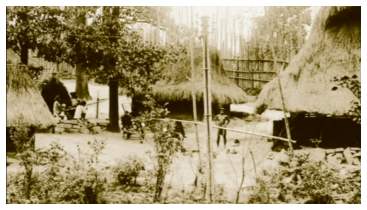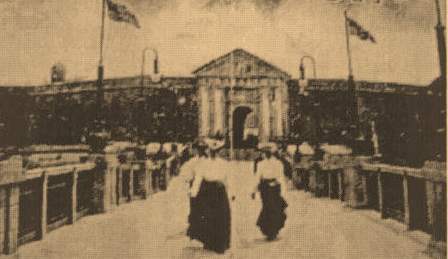Philippine's Exposition was located on a picturesque tract of 47
acres. It was in the center of the west section of the main Exposition
grounds, slightly further than the Agriculture building.
The exhibit was widely called a `reservation.'
The most striking feature of the exhibit was its naturalness. More than 1,100 persons were housed in the `reservation.' Native Filipinos were gathered in villages, in houses built by their own hands. They were shown on display, but lived, abiding by the customs of their various tribes.
Special attention had been paid to the landscaping of the 47 acres which included a large lake was at the service of the coastal tribes. The work of construction consisted of building a miniature city, with streets and parks and complete sewerage, water, and electric light, and fire-alarm systems. The ground plan included a central park or plaza, the sides of the quadrangle being occupied, respectively, by the cathedral or educational building, the typical Manila house, the commerce building, and the government or administration building, each of these beautiful structures being filled with appropriate exhibits. In addition there were separate exhibit buildings devoted to forestry, mines, and metallurgy, to agriculture and horticulture, to fish and game, and to ethnology, all artistically placed.
A reproduction of the ancient walls of Manila commanded the main
approach to the Philippine grounds. After crossing a miniature
reproduction of the Bridge of Spain, which spans the Pasig River at
Manila, visitors entered the Philippine reservation through the Real
gate.
Villages typical of the Philippine life, from the lowest grade to the better class, surrounded the main buildings, while on the south side were the quarters, camps, and parade grounds of the Philippine Constabulary and the Philippine Scouts.
Philippines showcased high-spirited patriotic pride, making sacrifices, in order that the resources and conditions of their country might appear in a dignified manner before the `civilized' world.
Many of the Honorary Philippine Commissioners had, as members of the Philippine Commission and as Governors of Provinces, largely contributed to the success of the Philippine display. As special guests of the Philippine Board, 50 Honorary Commissioners, appointed by the Philippine Government, these representative residents of the islands made a tour of the United States, investigating its industrial, commercial, social and economic conditions. They were entertained by President Roosevelt, and by prominent citizens in Chicago, Boston, Cincinnati and other large cities.
The Philippine display showcased the various tribes and their degree of civilization.
The Constabulary Guard, the native police-military organization of the
Philippines, were commanded by American and native and had an eighty piece band. John Philip Sousa said, after hearing a concert by this native band, "I marvel at their skill."
In the rear of the cuartel picturesquely encamped in the forest were the 400 Philippine Scouts, officered by regular army men. These men formed a part of the United States regular army, commanded by Major William H. Johnston. Included was a band of 45 natives. The Scouts had daily guard mounts, parades and regular drills prescribed by army regulations. Among these Scouts was one company of Macabebes, who were the best soldiers and most loyal subjects in the Islands.
Both Constabulary and Scouts lived inside the Walled City, which showcased a large collection of weapons.
The Visayan Village was located on the shore of Arrow Head
Lake. The complex of 20 houses was enclosed by a picturesque fence of lacedbamboo. The Visayans lived just as like they
were in their homes in the Islands. They were friendly, highly
intelligent and operated a market which contained many beautiful articles and fabrics, including: Jusi, Pina and Sinimay cloth, the making of embroidery, hats, mats, canes, etc. Pineapple fibers that were weaved into silk-like cloths dazzled the visitors. Wood-carving were also showcased. The village was 4 acres in size.
The Moros of Mindanao were also represented. Splint into two
tribes- the Samal Mores were coast dwellers, pirates and seafaring men; and the Lanao people- occupied the interior of Mindanao. Unlike the Lanao, the Samal Moros had been friendly
since American occupation, they lived on stilled huts over the water. Ruled over by Rajah Muda Mandi, an intelligent and wealthy man, who had the power of life and death over more than 5,000
subjects.
Since the hatred between between the two tribes was so intense, special guards were on duty in the villages to keep them separate.
Signs were posted not to photograph the Lanao as it was taboo with their Mohammedan faith. The Lanao had no problem showcasing their hatred for Christians and tended to stay in their huts and would not usually perform for visitors.
The Bagobos were also represented in the Philippines exhibit. They were pagan people from the southeastern coast of Mindanao, and wore costumes covered with multicolored beads. They were headhunters and rated the men on how many heads they had taken from an enemy. 40 Bagobos occupied this area, the men wore knee-pans and wielded 18" knives. Though fierce, they were said to be social and have a good sense of humor, as well as have good knowledge of commerce and agriculture.
The Bagobo Village did not open till September 12, because of their steamship- the Shawmut, caught fire before leaving Manilla. 38 Bagobos were afflicted with smallpox and had to be quarantined in St. Louis for several weeks.
The Igorote Village included three tribes; the Bontoc, The Suyoc and The Tinguanes. The Suyocs were the miners and show their method of extracting the metal from the ore, especially copper. They refused to wear clothing, so Fair signs warned visitors that they might see nudity in the Suyoc area. They had their own rice paddies and sweet potato patch. The Bontocs were the head-hunters. Tattooing was considered an art and the tribe were dog eaters (they were also called- cannibals, black hornets and head hunters). The Tinguanes were the agriculturists.
The Negritos were the aborigines of the Philippines. Darker in skin, in 1904, their population had decreased to 23,000. They were wanderers,
and were very skillful with the bow and arrow.
The Manguianes, occupied a special section of the Negrito Village, they were from the Island of Mindoro.
Also on `display' was the Philippine Midgets- Juan and Martina
De la Cruz, who were the smallest, fully developed people known in the
civilized world. Juan was 29 inches high and 29 years old. Martina
was 27 inches high and 31 years old. They were born in Iloilo, and their
parents were `average' size people.
On of the more picturesque areas of the lavishly floral Philippine exhibit was Arrow Head Lake. Luguna De Bay, or Arrow Head Lake, was a
beautiful sheet of water fronting the exhibit. The Moros gave
exhibitions on the lake of the way they handle their water crafts and
how to pearl fish. The lake was crossed by three bridges, illustrating native architecture, the main bridge being a reproduction of the famous structure over the Pasig, the "Puente De Espana."
The exhibit was heavily timbered and the forest area formed
an impressive sylvan background. The main entrance was through
the Walled City, reproducing the Spanish walls surrounding the City
of Manila, in which are exhibited relics of the various Philippine wars. An immense number of historic relics made this building an interesting museum.
The Education Building, fronting the main square was a reproduction of one of the most noted native cathedrals. The square was flanked on all sides by reproductions of well known structures in Manila.
The Game and Fisheries Building, bordering the lake, was a building
used for the purpose of displaying the native methods of hunting and capture of game, and the methods of fishing, including a collection
of mollusks. A full-sized stuffed water buffalo (Bubalus mindorensis Heude), and a 21-foot long by 1 foot thick python greeted visitors into this building.
The Forestry Building was made out of Philippine woods and had a long veranda of bamboo, shaded with coils of rattan. A number of specimens of hardwood were shown, the most valuable of which is narra, often mistaken for mahogany. Also on display was an exhibit of gutta-percha and rubber, which could be found in chewing gum.
The Mining Building contained over 2,000 samples of mineral products of the Philippine Islands. Shown were techniques and examples of copper ore, gold ore and coal, petroleum, sulphur, marble and a kind of kaolin, etc.
The Agriculture Building was 200 x 75 feet and showed the agricultural resources, horticultural products, tropical fruits and vehicles of land transportation. A large display of hemp was shown. The exhibits in this building numbered over 20,000 individual pieces, and received nine grand prizes, 4 gold medals, 179 silver medals, 145 bronze medals,
and 463 honorable mentions.
Building of Commerce what was in Manila before America's occupation. Also over 4,000 examples of goods were shown.
Manila House showcased many articles of domestic industry, mainly the work of women from all over the Philippine Archipelago.
Government Building.—The Government building represented an
imitation of the Ayuntamento Government building of the Insular
Government in Manila, and contained exhibits of art, liberal arts
and sciences.
Also on site was a 50-cot hospital.
An interesting feature of the reservation was a large relief map made by Father Algue, the Jesuit Priest, who was in charge of the Manila Observatory. His map covered an area of 110 x 75 feet. More than 2,000 islands were shown.
Though the Philippine exhibit was considered a `reservation,' there was some controversial and cultural problems in keeping diverse tribal peoples together, especially during the proper age of the Victorians. The organizers of this exhibit might have used trickery on some occasions in order to `recruit' tribal people for the Philippine Exhibit. Some of the Philippines were not aware of their destination until they arrived in St. Louis. The trip was long and difficult, but in general, the `recruits' were well-treated and well-fed.
Because of the novelty and well as the alleged savagery, the head-hunting, dog-eating Igorots were the most popular and financially successful (taking in- 200,387.18 dollars), exhibit on the Philippine `reservation.'
The city of St. Louis provided the Igorots with the agreed amount of 20 dogs a week. Because the supply of canines did not meet demand, the tribe encouraged local people to bring them dogs which they bought. The poaching of dogs became so common in the area near the Igorot Village that the neighborhood was warned to watch their own dogs. Many pups vanished.
St. Louis Women's Humane Society, protested the treatment to man's best friend, but many people sympathized the Igorot's need for dog meat.
One Missourian donated 200 fat dogs to the Igorots.
Cafe Michel was a 1,200 seat restaurant on the premises, while Cafe Luzon seated one thousand people.
On July 23, the head steward- Benjamine Jenkins of Cafe' Luzon was stabbed and later died while attempting to clear the Cafe at the end of the day, when an argument ensued. He died on November 3rd.







